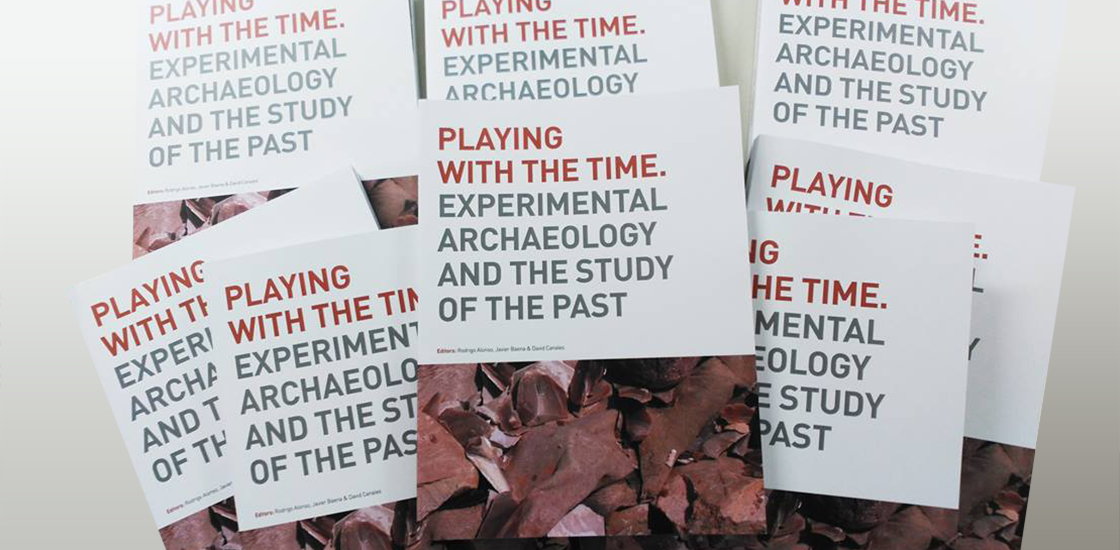
Increasingly, there is an appreciation of using experimental work to reconstruct how people squared up to the challenges of what life was like in the past. It is a field of archaeology which has caught the public imagination, so this collection of conference papers, Playing with the Time, edited by Alonso, Canale and Baena, has considerable potential to reach a wider market than just academics.
Spanish archaeology has adopted experimental archaeology with verve, with the Experimenta group, founded in 2005, promoting the dissemination of knowledge gained through experiments via conferences, journals and books. The introduction demonstrates that the most popular themes at past conferences have been lithics, traceology and pottery, with the Palaeolithic and Neolithic being best represented, but interestingly, the often neglected Iron Age has also proved popular (Alonso, Canales and Baena, 12-13). It is therefore useful that this book is divided into research ‘zones’, cutting to the chase for those with specific interests.
The Palaeolithic technology cluster starts audaciously, with Garcia Medrano’s chapter on the reconstruction of the Acheulean axes of Boxgrove, Sussex, setting the bar extremely high for subsequent papers in the section. However, each proceeding paper is of equally high standard. The cluster of papers on Mesolithic and Neolithic technology includes the reconstruction of prehistoric adhesives, by which even non-archaeologists will be fascinated (Fernandez-Marchena et al., 73-81).
The section on use-wear analysis is compulsory reading, as micro-wear analysis is a staple tool in any artefact analyst's scientific arsenal. From pottery to archery wrist-guards, there is a feast of ideas and information here. Lopez-Rodriguez’s work on traceology of sickles (113-119), and the function of Bolivian Pleistocene hunting tools (Clemente-Conte et al., 89-95) are particularly innovative. Osteoarchaeologists and biologists are not excluded, with a section on cut marks and diet. Methodologies range from the ultra-high-tech use of confocal laser profilometers to discover what kinds of tools were being used to hack bone (Fuentes-Sanchez et al, 171-177), through to examinations of fatty acid retention by ceramics (Santaolalla et al., 177-183).
The section dealing with rock art, music and display escorts the reader into the creative and aesthetic issues which often accompany past technologies. This is where experimentation explores enchantment, from the effects of light on rock art (Castellejo et al., 203-209) to the tone of Iron Age bells (Monells et al., 233-231). Such household magics of light, sound and fire allow for a seamless transition into analyses of utensils made from fire and earth – ceramics and metals. Practical work on firing pits is well explained, although Vidal’s examination of identifying right or left-handedness in pottery decoration (261-269) is particularly thought-provoking. Metalwork is not as strongly represented as metallurgists may wish, but Gallego et al’s., Iberian iron smelting work (275-281) is the stuff of future textbooks. Particularly delightful in the agriculture section is the paper by Indelicato and her team, examining the archaeology of wine in Sicily (321-329). One would suspect a considerable queue on any campus to participate in this experiment – and not all from archaeology departments.
Lopez-Castilla summarises the heart of the text succinctly, that experimental archaeology creates an empathy with the past therefore re-humanising it. Too often even the worthiest archaeological tomes make the past appear a sterile place. Certainly, the past was about survival, but for humanity, survival is insufficient. Peoples of the past sought laughter and delight in the same things as us, such as music, wine, the play of light, a beautifully made object or a great meal. It is remarkable how many of the papers are by groups, reinforcing shared experience, and working together. Perhaps that is the secret behind the rise in popularity of experimental archaeology, with both academic and layperson; it makes the past a warmer, recognisable place, inhabited by real people finding solutions to problems. This beautifully-presented ‘recipe book’ of practical knowledge is a perfect starter for the curious, and an invaluable handbook for the practitioner, deserving to be on academic library shelves worldwide.
Book information:
Playing with the time. Experimental archaeology and the study of the past. 4th. International Experimental Archaeology Conference. 8-11 may 2014, Museo de la Evolución Huma. Burgos, Spain by RodrigoAlonso, David Canales, Javier Baena (Eds.). 2017. Servicio de Publicaciones de la Universidad Autonoma de Madrid.
ISBN: 978-84-8344-594-5